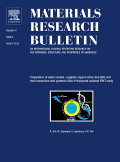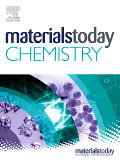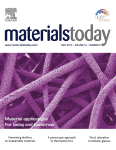
MATERIALS RESEARCH BULLETIN
Scope & Guideline
Elevating research standards in materials science.
Introduction
Aims and Scopes
- Nanomaterials and Nanocomposites:
Research on the synthesis, characterization, and application of nanostructured materials, including their potential in areas such as energy storage, catalysis, and environmental remediation. - Photocatalytic and Photothermal Materials:
Studies focusing on materials that can facilitate photocatalytic reactions or exhibit photothermal effects, particularly for environmental applications like pollutant degradation and hydrogen production. - Electrochemical Applications:
Exploration of materials for energy storage and conversion technologies, including batteries, supercapacitors, and fuel cells, with a focus on enhancing efficiency and stability. - Magnetic and Dielectric Materials:
Investigations into materials with unique magnetic and dielectric properties, including their use in sensors, microwave applications, and energy harvesting. - Sustainable and Green Materials:
Research into environmentally friendly materials and processes, including bio-based materials and recycling methods, aimed at reducing the ecological footprint of materials production. - Optoelectronic Materials:
Studies on materials with optical properties suitable for applications in photonics, including luminescent materials, phosphors, and devices such as LEDs and lasers.
Trending and Emerging
- 2D Materials and Heterostructures:
An increasing number of studies focus on two-dimensional materials, such as graphene and transition metal dichalcogenides, particularly in the context of their integration into heterostructures for enhanced electronic and optoelectronic applications. - Biomaterials and Biocompatibility:
There is a growing emphasis on the development of biomaterials for medical applications, including drug delivery systems and tissue engineering, reflecting the increasing intersection of materials science with biomedical engineering. - Energy Harvesting and Storage:
Research on materials for energy harvesting and storage, particularly those enhancing the performance of batteries and supercapacitors, has gained momentum, driven by the global push for sustainable energy solutions. - Photonic and Plasmonic Materials:
Emerging research focuses on materials that leverage photonic and plasmonic effects for applications in sensors, imaging, and telecommunications, showcasing advances in materials that manipulate light at the nanoscale. - Recyclable and Eco-friendly Materials:
A notable trend towards the development of recyclable materials and those derived from sustainable practices is evident, aligning with global sustainability goals and the need for environmentally friendly solutions. - Machine Learning and AI in Materials Design:
The integration of machine learning and artificial intelligence in materials design is emerging as a significant theme, facilitating the discovery of new materials and optimization of existing ones through computational methods.
Declining or Waning
- Traditional Bulk Materials:
Research on conventional bulk materials, such as metals and ceramics, has seen a decline, possibly due to the increasing interest in advanced nanomaterials and composites with superior properties. - Single-Function Materials:
There seems to be a waning interest in materials designed for a single application. Researchers are increasingly focusing on multifunctional materials that can serve multiple purposes, such as combining electrical conductivity with photocatalytic activity. - Theoretical Studies without Experimental Validation:
The journal appears to be publishing fewer purely theoretical studies that lack experimental backing, as the emphasis shifts towards research that demonstrates practical applicability and experimental validation. - Conventional Synthesis Techniques:
There is a noticeable reduction in publications utilizing traditional synthesis methods in favor of innovative, eco-friendly, or more efficient synthesis approaches, reflecting the broader trend towards sustainability.
Similar Journals

Materials Today Chemistry
Exploring Breakthroughs in Material ApplicationsMaterials Today Chemistry, published by Elsevier Science Ltd, is a leading journal in the field of materials science, with a primary focus on innovative research and advancements in chemistry relating to materials. Operating under ISSN 2468-5194, the journal has made a significant impact in various specialized areas such as biomaterials, catalysis, colloid and surface chemistry, and polymers, achieving a Q1 ranking across these categories in 2023. With its commitment to high-quality, peer-reviewed content, Materials Today Chemistry serves as an essential platform for researchers, professionals, and students aiming to stay at the forefront of materials research. The journal provides an open access model, enabling wide dissemination of research findings and fostering collaboration among the scientific community. Its esteemed ranking on Scopus, including a remarkable percentile position in materials chemistry and catalysis, underscores its importance in advancing the understanding and application of novel materials. Whether you're delving into cutting-edge synthesis techniques or exploring the latest in materials applications, Materials Today Chemistry remains a pivotal resource for breakthrough discoveries and pivotal insights in the realm of materials science.

Materials Today
Elevating Research Standards in Mechanical EngineeringMaterials Today is a premier academic journal published by Elsevier Science Ltd, specializing in the dynamic fields of materials science, mechanical engineering, and condensed matter physics. Established in 1999, the journal has garnered an enviable reputation, consistently ranking in the Q1 category across multiple disciplines including mechanics of materials and general materials science, reflecting its influence and high-quality research output. With an impressive Scopus ranking—4th in both mechanical engineering and mechanics of materials, and 6th in condensed matter physics—Materials Today serves as an essential resource for researchers, professionals, and students seeking to stay at the forefront of developments in material innovations and applications. The journal is known for its commitment to publishing significant research findings and reviews, making it a vital platform for disseminating knowledge and fostering collaboration in the rapidly evolving materials field. Although it does not offer open access, its robust impact factor underscores the importance of the content published, ensuring wide visibility and citation among the academic community. Explore the rich tapestry of materials research with Materials Today, where groundbreaking insights pave the way for future technological advancements.

Advanced Materials Interfaces
Elevating Materials Science through Open Access InsightsAdvanced Materials Interfaces is a premier journal dedicated to the exploration and advancement of materials science, with particular emphasis on the interfacial phenomena that govern the behavior of materials in various engineering applications. Published by WILEY in the United Kingdom, this Open Access journal, established in 2014, has quickly ascended to a Q1 category ranking in both Mechanical Engineering and Mechanics of Materials as of 2023, reflecting its significant influence and excellence in the field. With impressive Scopus Ranks, such as #81 out of 672 in Mechanical Engineering and #58 out of 398 in Mechanics of Materials, it serves as a vital resource for researchers and practitioners aiming to push the boundaries of materials innovation. The journal provides unrestricted access to its cutting-edge research, promoting collaboration and dissemination of knowledge among the global scientific community, solidifying its role as a vital contributor to the ever-evolving landscape of materials engineering.

JOURNAL OF CLUSTER SCIENCE
Exploring the Frontiers of Cluster ScienceJOURNAL OF CLUSTER SCIENCE, published by SPRINGER/PLENUM PUBLISHERS, is a prominent and influential journal in the fields of Biochemistry, Chemistry, Condensed Matter Physics, and Materials Science. With an ISSN of 1040-7278 and E-ISSN of 1572-8862, this journal has been contributing to scientific discourse since its inception in 1990 and continues to publish cutting-edge research through 2024. It holds a respectable position in the academic landscape with its category quartiles indicating a Q3 ranking in Biochemistry and Q2 rankings in Chemistry, Condensed Matter Physics, and Materials Science as of 2023. The journal's noteworthy Scopus rankings further underscore its relevance, particularly a rank of #82 in Condensed Matter Physics, showcasing its impact and the quality of research disseminated. Although it does not currently offer open access options, it remains a key resource for researchers, professionals, and students who are invested in understanding the complexities of cluster science and its interdisciplinary applications.

Journal of Materials Chemistry C
Catalyzing Discoveries in Materials ChemistryJournal of Materials Chemistry C, published by the renowned Royal Society of Chemistry, is a leading academic journal focusing on innovative research in the field of materials chemistry. With an impressive impact factor, this journal has solidified its status as a top-tier publication within its field, ranking in the Q1 category for both Chemistry (miscellaneous) and Materials Chemistry as of 2023. Positioned at the forefront of -materials science, it serves as a vital platform for researchers, professionals, and students to disseminate findings that highlight the synthesis, characterization, and application of advanced materials. The journal's open access model allows for broader readership and engagement, ensuring that groundbreaking research is accessible to a global audience. As a result, the Journal of Materials Chemistry C plays a crucial role in advancing the understanding and technology of materials, fostering collaboration and innovation within this dynamic scientific community.

ACS Materials Au
Unleashing Potential Through Open Access ResearchACS Materials Au, published by the American Chemical Society, is a premier open-access journal that has been at the forefront of materials science since its inception in 2021. With an ISSN of 2694-2461, this journal encompasses an expansive range of topics including biomaterials, electronic, optical and magnetic materials, materials chemistry, and polymers and plastics, consistently achieving Q1 rankings in these categories for 2023. The journal is based in the United States and operates from the AMS's headquarters in Washington, DC, offering significant visibility and a robust platform for researchers. The journal's commitment to open access ensures wide dissemination of groundbreaking research, enabling a diverse audience—including researchers, professionals, and students—to engage with the latest advancements in materials science. With an encouraging impact factor and a focus on novel materials and innovative applications, ACS Materials Au stands as a vital resource for anyone devoted to understanding and advancing the frontiers of materials engineering and science.

Nano Materials Science
Transforming Theoretical Insights into Practical Solutions.Nano Materials Science is a premier open-access journal dedicated to the dissemination of groundbreaking research in the fields of nanotechnology, materials science, and chemical engineering. Published by KEAI PUBLISHING LTD, this journal has quickly established itself as a leading platform in its area since its inception in 2019, with impressive rankings in the Scopus database, holding a Q1 position across multiple categories, including Chemical Engineering and Materials Science. Based in Beijing, China, Nano Materials Science provides researchers and practitioners access to a wealth of high-quality peer-reviewed articles, fostering innovation and collaboration within the scientific community. With its impact factor steadily rising and a commitment to open access, the journal aims to bridge the gap between theoretical research and practical applications, making it an essential resource for professionals and students eager to stay at the forefront of materials research and nanotechnology advancements.

MATERIALS CHEMISTRY AND PHYSICS
Connecting Science and Innovation in Materials ResearchMATERIALS CHEMISTRY AND PHYSICS is a leading peer-reviewed journal published by Elsevier Science SA, focusing on the intersection of materials science and condensed matter physics. With an esteemed impact factor and a distinguished reputation in its field, this journal holds a Q1 ranking in Condensed Matter Physics and a Q2 ranking in miscellaneous Materials Science categories as of 2023. Spanning over three decades since its inception in 1983, it provides a vital platform for researchers, professionals, and students to disseminate cutting-edge findings and innovations in materials characterization, properties, and applications. The journal is indexed in Scopus, boasting impressive rankings that reflect its commitment to publishing high-quality research. Although it does not currently offer an Open Access option, it remains an essential resource for those seeking to stay at the forefront of materials chemistry and physics.

JOURNAL OF MATERIALS SCIENCE-MATERIALS IN ELECTRONICS
Driving Progress in Electronic Materials ResearchJOURNAL OF MATERIALS SCIENCE-MATERIALS IN ELECTRONICS, published by Springer, is a distinguished international journal that serves as a vital platform for the dissemination of cutting-edge research in the field of materials science, with a keen focus on electronics. Since its inception in 1990, this journal has consistently contributed to the advancement of knowledge across a range of interdisciplinary categories, including Atomic and Molecular Physics, Optical and Magnetic Materials, and Biomedical Engineering, achieving notable quartile positions in various 2023 Scopus rankings. With an impact factor that signifies its scholarly influence, this journal provides a rigorous peer-reviewed environment for researchers and practitioners to share innovative ideas, experimental findings, and theoretical developments. Although it does not currently offer open access options, the depth and breadth of topics covered—including condensed matter physics and bioengineering—make it an essential resource for those at the forefront of materials research. With a commitment to bridging the gap between theory and practical application, the JOURNAL OF MATERIALS SCIENCE-MATERIALS IN ELECTRONICS continues to pave the way for future explorations in the ever-evolving landscape of materials science.

SOLID STATE SCIENCES
Leading the Charge in Solid State AdvancementsSOLID STATE SCIENCES is an influential academic journal published by Elsevier, focusing on advancements in the fields of chemistry, condensed matter physics, and materials science. With an ISSN of 1293-2558 and an E-ISSN of 1873-3085, this journal has been at the forefront of disseminating innovative research since its inception in 1999 and is projected to continue until 2024. Positioned in the prestigious Q2 category in multiple disciplines for 2023, SOLID STATE SCIENCES ranks #87 in condensed matter physics, #101 in general chemistry, and #124 in general materials science within Scopus. Researchers and professionals in these fields will find this journal indispensable, offering open access options that enhance global visibility and accessibility of cutting-edge research, fostering collaboration and innovation. With its commitment to showcasing substantial contributions and novel methodologies, SOLID STATE SCIENCES plays a vital role in shaping the future of materials research.